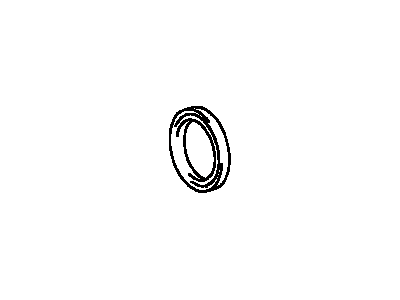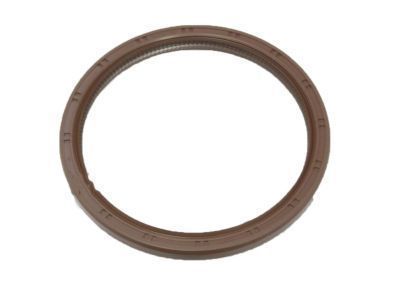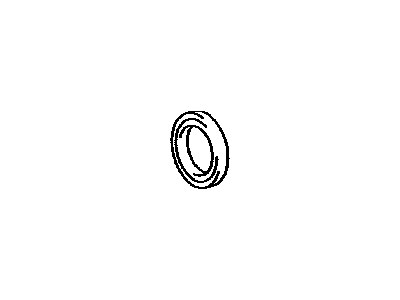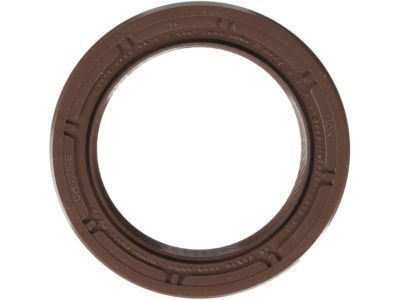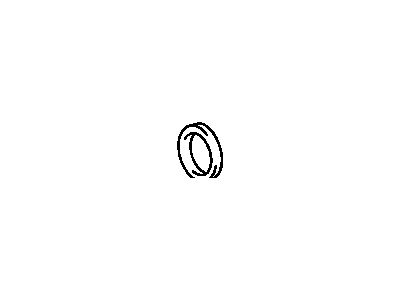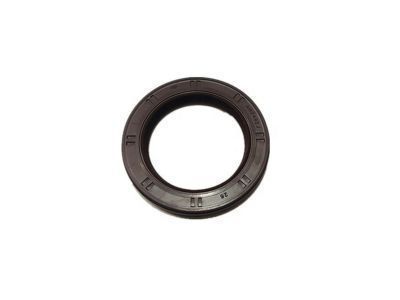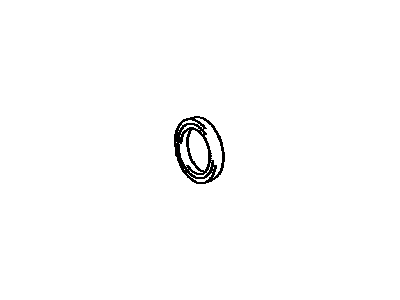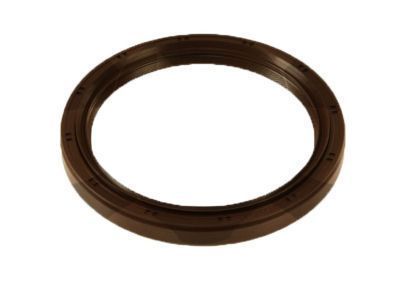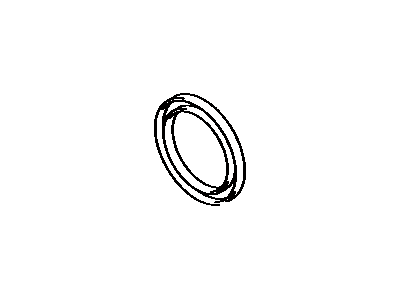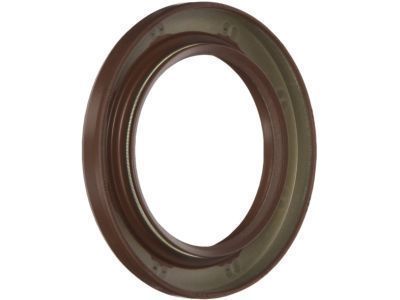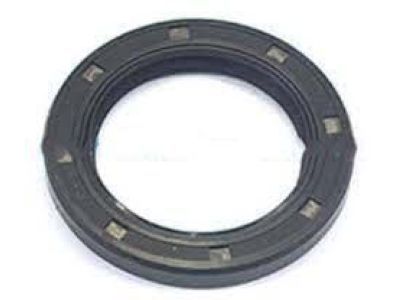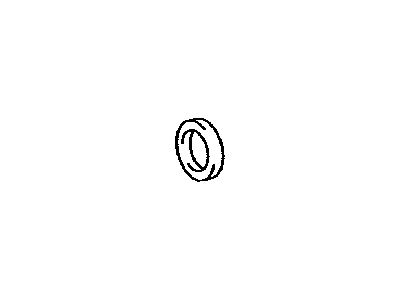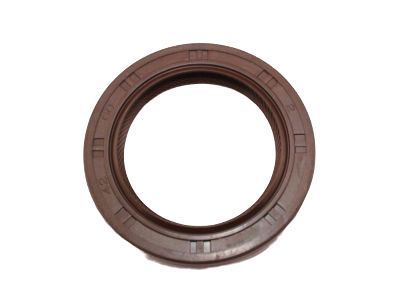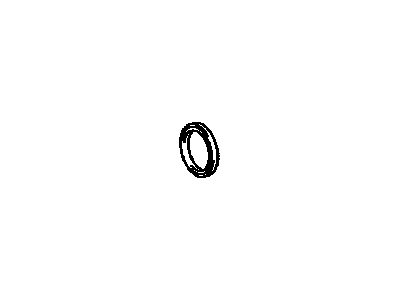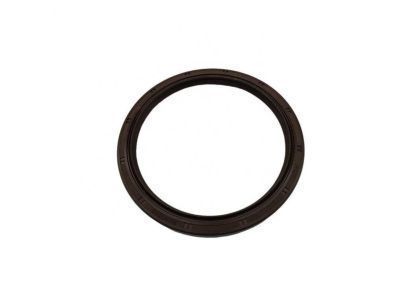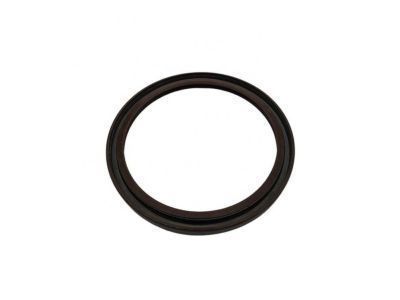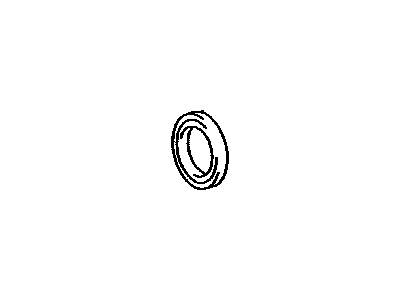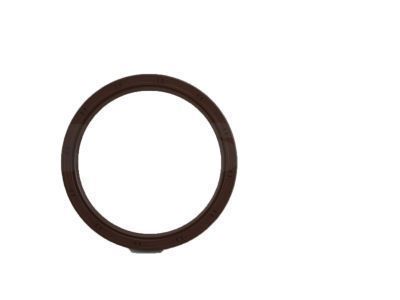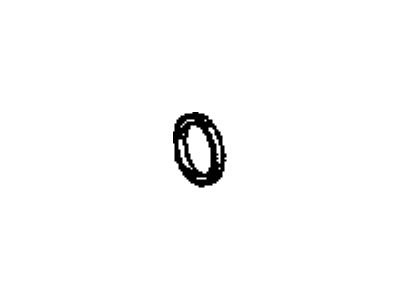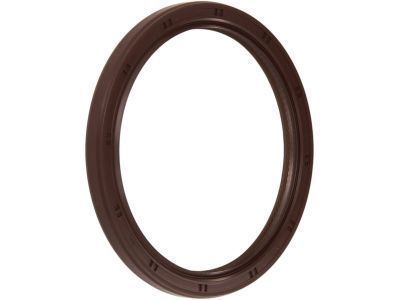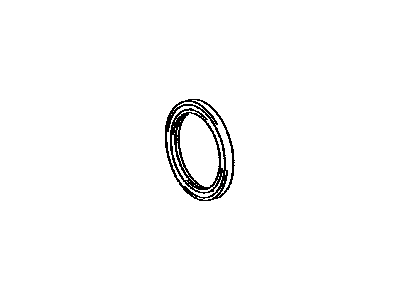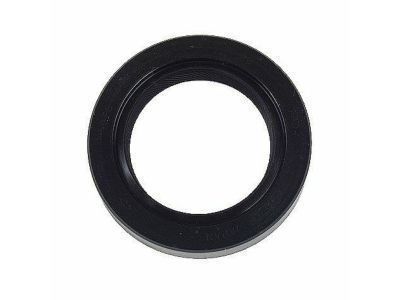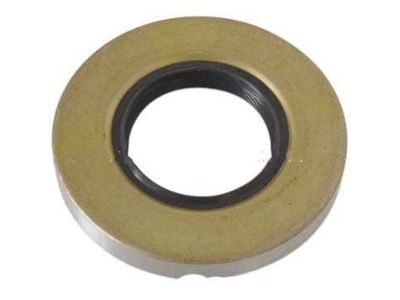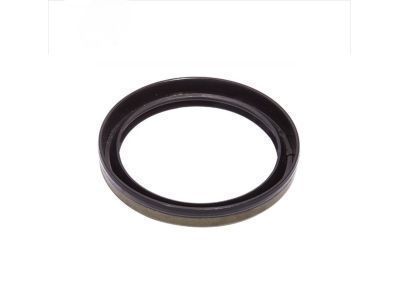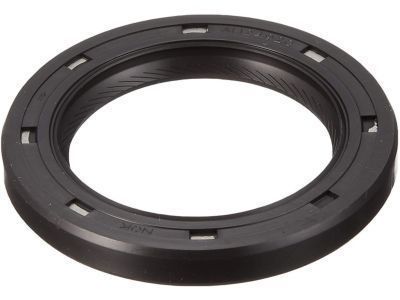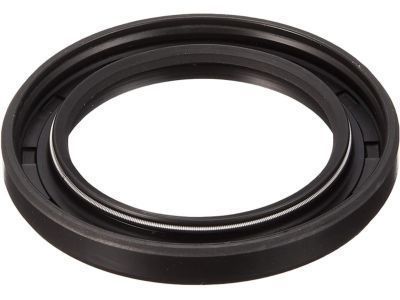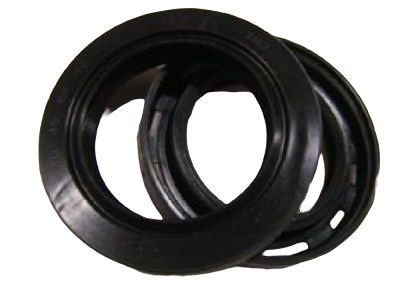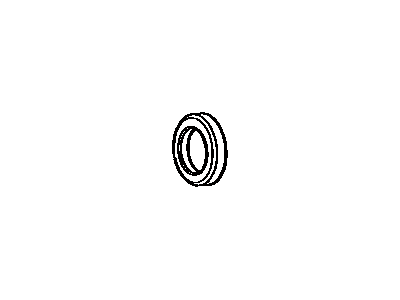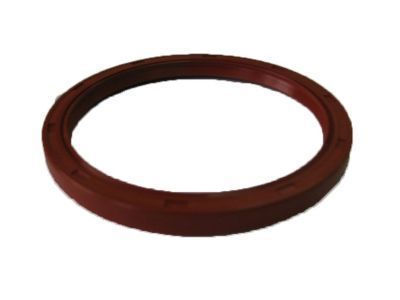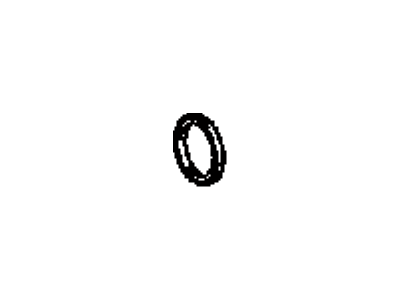Menu


My Garage
My Account
Cart
Genuine Toyota 4Runner Crankshaft Seal
- Select Vehicle by Model
- Select Vehicle by VIN
Select Vehicle by Model
orMake
Model
Year
Select Vehicle by VIN
For the most accurate results, select vehicle by your VIN (Vehicle Identification Number).
23 Crankshaft Seals found
Toyota 4Runner Seal, Engine Rear Oil
Part Number: 90311-92006$43.90 MSRP: $61.37You Save: $17.47 (29%)Ships in 1-3 Business DaysADD TO CARTProduct Specifications- Manufacturer Note: *132
- Position: Rear
- Replaced by: 90311-A0027
- Warranty: This genuine part is guaranteed by Toyota's factory warranty.
Fits the following Vehicles:- 1991-2002 Toyota 4Runner | DLX, LULI, SR5, SR5B, SR5V, STD | 4 Cyl 2.4L, 4 Cyl 2.7L, 6 Cyl 3.0L, 6 Cyl 3.4L | 22R, 22RE, 3RZFE, 3VZE, 5VZFE; RN101L-TRLDEA, RN101L-TRLDEAB, RN101L-TRLDEK, RN101L-TRLSEA, RN101L-TRMDEA, RN101L-TRMDEAB, RN101L-TRMDEK, RN101L-TRMSEA, RN101L-TRPDEA, RN101L-TRPDEAB, RN106L-TRLDEA, RN106L-TRLDEK, RN106L-TRMDEA, RN106L-TRMDEK, RN106L-TRPDEA, RN106L-TRPDEK, RN110L-CRLDEA, RN110L-CRLDEK, RN110L-CRLSEA, RN110L-CRMDEA, RN110L-CRMDEAB, RN110L-CRMDEK, RN110L-CRMSEA, RN110L-CRPDEA, RN110L-CRPSEA, RN120L-GKPSEA, RN121L-RKMSEK, RN121L-RKPSEK, RN130L-GJLSEA, RN130L-GJMSEA, RN130L-GJPSEA, RN130L-GKLSEA, RN130L-GKMSEA, RN130L-GKPSEA, RN131L-RJLSEK, RN131L-RJMSEK, RN131L-RJPSEK, RN131L-RKLSEK, RN131L-RKMSEK, RN131L-RKPSEK, RN80L-TRKREA, RN80L-TRLDSA, RN80L-TRMDEA, RN80L-TRMREA, RN80L-TRMREK, RN80L-TRMRSK, RN80L-TRSDEA, RN80L-TRTRSA, RN85L-TRLDSA, RN85L-TRMDEA, RN85L-TRMDEK, RN85L-TRMDSK, RN85L-TRMSEA, RN85L-TRSDEA, RN85L-TRSDEK, RN85L-TRSSEA, RN90L-CRLDSA, RN90L-CRMDEA, RN90L-CRMDEK, RN90L-CRMDSK, RN90L-CRMSEA, RN90L-CRSDEA, RN90L-CRSDEK, RN90L-CRSSEA, RZN180L-GKMSKA, RZN180L-GKPSKA, RZN185L-GKMSKA, RZN185L-GKPSKA, VZN100L-TRMDEA, VZN100L-TRMDEAB, VZN100L-TRMDEK, VZN100L-TRMGEA, VZN105L-TRMDEA, VZN105L-TRMDEK, VZN105L-TRPDEA, VZN110L-CRMDEA, VZN110L-CRMDEAB, VZN110L-CRMDEK, VZN110L-CRMGEA, VZN110L-CRMGEK, VZN110L-CRPDEA, VZN110L-CRPDEAB, VZN110L-CRPDEK, VZN110L-CRPGEA, VZN120L-GKPGEA, VZN130L-GJMGEA, VZN130L-GJPGEA, VZN130L-GKMGEA, VZN130L-GKPGEA, VZN131L-RJMGEK, VZN131L-RJPGEK, VZN131L-RKMGEK, VZN131L-RKPGEK, VZN180L-GKPGKA, VZN180L-GKPSKA, VZN180L-GKPZKA, VZN185L-GKMGKA, VZN185L-GKPGKA, VZN185L-GKPSKA, VZN185L-GKPZKA, VZN85L-THMDEA, VZN85L-THSDEA, VZN85L-TRMDEA, VZN85L-TRMDEK, VZN85L-TRMREA6, VZN85L-TRSDEA, VZN85L-TRSDEK, VZN85L-TRSREA6, VZN85L-TWMREA6, VZN85L-TWSREA6, VZN90L-CRMDEA, VZN90L-CRMDEK, VZN90L-CRMGEA, VZN90L-CRMGEK, VZN90L-CRPGEA, VZN90L-CRSDEA, VZN90L-CRSDEK, VZN95L-TWMREA6, VZN95L-TWSREA6, VZN95L-TWSREK6
Toyota 4Runner Seal, Engine Rear Oil
Part Number: 90311-99010$53.66 MSRP: $75.00You Save: $21.34 (29%)Ships in 1-3 Business DaysADD TO CARTProduct Specifications- Manufacturer Note: (J)
- Position: Rear
- Replaced by: 90311-A0006
- Warranty: This genuine part is guaranteed by Toyota's factory warranty.
Fits the following Vehicles:- 2003-2024 Toyota 4Runner | Limited, SR5 | 4 Cyl 2.7L, 6 Cyl 4.0L, 8 Cyl 4.7L | 1GRFE, 2TRFE, 2UZFE; GRN210L-GKAGKA, GRN210L-GKAZKA, GRN210L-GKPGKA, GRN210L-GKPZKA, GRN215L-GKAGKA, GRN215L-GKAZKA, GRN215L-GKPGKA, GRN215L-GKPZKA, GRN280L-GKAGKA, GRN285L-GKAGKA, TRN280L-GKPGKA, TRN285L-GKPGKA, UZN210L-GKAGKA, UZN210L-GKAZKA, UZN215L-GKAGKA, UZN215L-GKAZKA
Toyota 4Runner Oil Seal
Part Number: 90311-48014$12.96 MSRP: $18.11You Save: $5.15 (29%)Ships in 1-3 Business DaysADD TO CARTProduct Specifications- Other Name: Seal, Oil(For Timing Gear Case Or Timing Chain Case)
- Warranty: This genuine part is guaranteed by Toyota's factory warranty.
Fits the following Vehicles:- 1996-2001 Toyota 4Runner | LULI, SR5B, SR5V | 4 Cyl 2.7L, 6 Cyl 3.4L | 3RZFE, 5VZFE; RZN180L-GKMSKA, RZN180L-GKPSKA, RZN185L-GKMSKA, RZN185L-GKPSKA, VZN180L-GKPGKA, VZN180L-GKPSKA, VZN180L-GKPZKA, VZN185L-GKMGKA, VZN185L-GKPGKA, VZN185L-GKPSKA, VZN185L-GKPZKA
Toyota 4Runner Oil Seal
Part Number: 90311-42036$19.03 MSRP: $26.60You Save: $7.57 (29%)Ships in 1-2 Business DaysADD TO CARTProduct Specifications- Other Name: Seal, Oil(For Timing Gear Case Or Timing Chain Case)
- Replaced by: 90311-A0005
- Warranty: This genuine part is guaranteed by Toyota's factory warranty.
Fits the following Vehicles:- 2003-2005 Toyota 4Runner | Limited, SR5 | 6 Cyl 4.0L, 8 Cyl 4.7L | 1GRFE, 2UZFE; GRN210L-GKAGKA, GRN210L-GKAZKA, GRN210L-GKPGKA, GRN210L-GKPZKA, GRN215L-GKAGKA, GRN215L-GKAZKA, GRN215L-GKPGKA, GRN215L-GKPZKA, UZN210L-GKAGKA, UZN210L-GKAZKA, UZN215L-GKAGKA, UZN215L-GKAZKA
Toyota 4Runner Seal, Engine Rear Oil
Part Number: 90311-80010$42.95 MSRP: $60.03You Save: $17.08 (29%)Ships in 1-3 Business DaysADD TO CARTProduct Specifications- Other Name: Rear Main Seal
- Position: Rear
- Replaces: 90311-80004
- Warranty: This genuine part is guaranteed by Toyota's factory warranty.
Fits the following Vehicles:- 1984-1995 Toyota 4Runner | DLX, SDT, SR5, SR5 Turbo, STD | 4 Cyl 2.4L, 6 Cyl 3.0L | 22R, 22RE, 22REC, 22RTEC, 2L, 2LT, 3VZE; LN51L-KRA, 3VZE; RN101L-TRLDEA, LN51L-KRA3, LN56L-MDA3, LN56L-MDCA, LN56L-MDCA3, LN56L-MDCK, LN56L-MDCXA3, LN56L-MDK, LN56L-MDXA3, LN56L-MRK, LN65L-MDA, LN65L-MDA3, LN65L-MDCA3, LN65L-MDCK, LN65L-MDXA, LN65L-MDXA3, LN65L-MDXK, LN66L-MDCXK, RN101L-TRLDEA, RN101L-TRLDEAB, RN101L-TRLDEK, RN101L-TRLSEA, RN101L-TRLSEA3, RN101L-TRMDEA, RN101L-TRMDEA3, RN101L-TRMDEAB, RN101L-TRMDEK, RN101L-TRMSEA, RN101L-TRMSEA3, RN101L-TRPDEA, RN101L-TRPDEAB, RN106L-TRLDEA, RN106L-TRLDEK, RN106L-TRMDEA, RN106L-TRMDEA3, RN106L-TRMDEK, RN106L-TRPDEA, RN106L-TRPDEA3, RN106L-TRPDEK, RN110L-CRLDEA, RN110L-CRLDEK, RN110L-CRLSEA, RN110L-CRLSEA3, RN110L-CRMDEA, RN110L-CRMDEA3, RN110L-CRMDEAB, RN110L-CRMDEK, RN110L-CRMSEA, RN110L-CRMSEA3, RN110L-CRPDEA, RN110L-CRPDEA3, RN110L-CRPSEA, RN110L-CRPSEA3, RN120L-GKPSEA, RN121L-RKMSEK, RN121L-RKPSEK, RN130L-GJLSEA, RN130L-GJMSEA, RN130L-GJPSEA, RN130L-GKLSEA, RN130L-GKMSEA, RN130L-GKPSEA, RN131L-RJLSEK, RN131L-RJMSEK, RN131L-RJPSEK, RN131L-RKLSEK, RN131L-RKMSEK, RN131L-RKPSEK, RN50L-KRA, RN50L-KRK, RN50L-LRA, RN50L-MRA, RN50L-MSEA, RN50L-MSEA3, RN50L-PRA, RN50L-SRA, RN50L-SREA, RN50L-TRA, RN55L-KDA3W, RN55L-KDEA3W, RN55L-KDEK3W, RN55L-KDK3W, RN55L-KRA3W, RN55L-KREA3W, RN55L-KRTEA3W, RN55L-LDA, RN55L-LDA3, RN55L-LRA, RN55L-MDA, RN55L-MDA3, RN55L-MDCA, RN55L-MDCA3, RN55L-MDCK, RN55L-MGCZA, RN55L-MGCZA3, RN55L-MRA, RN55L-MRHA, RN55L-MRHA3, RN55L-MRHEA, RN55L-MRHEK, RN55L-MRHK, RN55L-MRK, RN55L-MSCEA, RN55L-MSCEA3, RN55L-MSCEK, RN55L-MSCZA, RN55L-MSCZA3, RN55L-MSEA, RN55L-MSEA3, RN55L-MSEK, RN55L-PDA, RN55L-PDA3, RN55L-PDCA, RN55L-PDCA3, RN55L-PDCK, RN55L-PDEA3W, RN55L-PDEK3W, RN55L-PDK, RN55L-PGCZA, RN55L-PGCZA3, RN55L-PGCZK, RN55L-PRA, RN55L-PRK, RN55L-PSCEA, RN55L-PSCEA3, RN55L-PSCEK, RN55L-PSEA3, RN55L-SDA, RN55L-SDEA, RN55L-SDEA3, RN55L-SRA, RN55L-SREA, RN55L-SREA3W, RN55L-SREK, RN55L-SRHEA, RN55L-SRHEK, RN55L-SRK, RN55L-SRTEA3W, RN60L-MDK, RN60L-MRA, RN60L-MRA3, RN60L-MSA, RN60L-MSA3, RN60L-MSEA, RN60L-MSEA3, RN60LG-MDA, RN60LG-MDEA, RN60LG-MSA, RN60LG-MSEA, RN60LG-PDEA, RN60LV-MDA, RN60LV-MDEA, RN60LV-MSEK, RN60LV-MSK, RN60LV-PDEA, RN60LV-PSEK, RN61L-MBZA, RN61L-MBZA3, RN61L-MDK, RN61L-MRA, RN61L-MRA3, RN61L-MREA, RN61L-MREA3, RN61L-MREK, RN61L-MSEA, RN61L-MSEA3, RN61LG-MDEA, RN61LG-MSEA, RN61LG-PDEA, RN61LG-PGZA, RN61LG-PSEA, RN61LV-MDEA, RN61LV-MDEK, RN61LV-MSEA, RN61LV-MSEK, RN61LV-PDEA, RN61LV-PDEK, RN61LV-PGZK, RN61LV-PSEA, RN61LV-PSEK, RN65L-MDA, RN65L-MDA3, RN65L-MDCA, RN65L-MDCA3, RN65L-MDK, RN65L-MSA3, RN65L-MSCA, RN65L-MSCA3, RN65L-MSCEA, RN65L-MSCEA3, RN65L-MSCEK, RN65L-MSCK, RN65L-MSEA3, RN65L-MSEK, RN65L-MSK, RN65L-PDCEA, RN65L-PDCEA3, RN65L-PDEA, RN65L-PDEA3, RN65L-PDEK, RN65L-PSCEK, RN66L-MDA, RN66L-MDA3, RN66L-MDCA, RN66L-MDCA3, RN66L-MDCEA, RN66L-MDCEA3, RN66L-MDCEK, RN66L-MDEA, RN66L-MDEA3, RN66L-MDEK, RN66L-MDK, RN66L-MGCZA, RN66L-MGCZA3, RN66L-MGCZK, RN66L-MRA, RN66L-MSCEA, RN66L-MSCEA3, RN66L-MSCEK, RN66L-MSEA3, RN66L-MSEK, RN66L-PDCEA, RN66L-PDCEA3, RN66L-PDEA, RN66L-PDEA3, RN66L-PDEK, RN66L-PGCZA, RN66L-PGCZA3, RN66L-PGCZK, RN66L-PSCEA3, RN66L-PSCEK, RN70L-LDCA3, RN70L-LRCA, RN70L-LRCA3, RN70L-MDCA, RN70L-MDCA3, RN70L-MDCK, RN70L-MRCA, RN70L-MRCA3, RN70L-MRCK, RN70L-SDCA, RN70L-SDCA3, RN70L-SDCEA3, RN70L-SDCK, RN70L-SRCA, RN70L-SRCEA, RN70L-SRCEA3, RN70L-SRCEK, RN70L-SRCK, RN75L-KRTEA3W, RN75L-PDTEA3W, RN75L-SDTEA3W, RN75L-SDTEK3W, RN80L-TRKREA, RN80L-TRKRSA, RN80L-TRKRSA3, RN80L-TRLDSA, RN80L-TRLDSA3, RN80L-TRMDEA, RN80L-TRMDEA3, RN80L-TRMDEAB, RN80L-TRMREA, RN80L-TRMREAB, RN80L-TRMREK, RN80L-TRMRSK, RN80L-TRSDEA, RN80L-TRSDEA3, RN80L-TRSDEAB, RN80L-TRTRSA, RN80L-TRTRSA3, RN85L-TRLDSA, RN85L-TRLDSA3, RN85L-TRMDEA, RN85L-TRMDEA3, RN85L-TRMDEK, RN85L-TRMDSK, RN85L-TRMSEA, RN85L-TRMSEA3, RN85L-TRSDEA, RN85L-TRSDEA3, RN85L-TRSDEK, RN85L-TRSSEA, RN85L-TRSSEA3, RN90L-CRLDSA, RN90L-CRLDSA3, RN90L-CRMDEA, RN90L-CRMDEA3, RN90L-CRMDEAB, RN90L-CRMDEK, RN90L-CRMDSK, RN90L-CRMSEA, RN90L-CRMSEA3, RN90L-CRSDEA, RN90L-CRSDEA3, RN90L-CRSDEK, RN90L-CRSSEA, RN90L-CRSSEA3, VZN100L-TRMDEA, VZN100L-TRMDEA3, VZN100L-TRMDEAB, VZN100L-TRMDEK, VZN100L-TRMGEA, VZN100L-TRMGEA3, VZN105L-TRMDEA, VZN105L-TRMDEA3, VZN105L-TRMDEK, VZN105L-TRPDEA, VZN105L-TRPDEA3, VZN110L-CRMDEA, VZN110L-CRMDEA3, VZN110L-CRMDEAB, VZN110L-CRMDEK, VZN110L-CRMGEA, VZN110L-CRMGEA3, VZN110L-CRMGEK, VZN110L-CRPDEA, VZN110L-CRPDEA3, VZN110L-CRPDEAB, VZN110L-CRPDEK, VZN110L-CRPGEA, VZN110L-CRPGEA3, VZN120L-GKPGEA, VZN130L-GJMGEA, VZN130L-GJPGEA, VZN130L-GKMGEA, VZN130L-GKPGEA, VZN131L-RJMGEK, VZN131L-RJPGEK, VZN131L-RKMGEK, VZN131L-RKPGEK, VZN61L-MBEA, VZN61L-MBEA3, VZN61L-MSEA, VZN61L-MSEA3, VZN61LG-MSEA, VZN61LG-PSEA, VZN61LV-MDEA, VZN61LV-MSEA, VZN61LV-MSEK, VZN61LV-PDEA, VZN61LV-PSEA, VZN61LV-PSEK, VZN66L-MDCEA3, VZN66L-MDCEK, VZN66L-MDEA3, VZN66L-MDEK, VZN66L-MSCEA, VZN66L-MSCEA3, VZN66L-MSCEK, VZN66L-PDCEA3, VZN66L-PDEA3, VZN66L-PDEK, VZN66L-PSCEA3, VZN66L-PSCEK, VZN85L-THMDEA, VZN85L-THMDEA3, VZN85L-THSDEA, VZN85L-THSDEA3, VZN85L-TRMDEA, VZN85L-TRMDEA3, VZN85L-TRMDEK, VZN85L-TRMREA6, VZN85L-TRSDEA, VZN85L-TRSDEA3, VZN85L-TRSDEK, VZN85L-TRSREA6, VZN85L-TWMREA6, VZN85L-TWSREA6, VZN90L-CRMDEA, VZN90L-CRMDEA3, VZN90L-CRMDEK, VZN90L-CRMGEA, VZN90L-CRMGEA3, VZN90L-CRMGEK, VZN90L-CRPGEA, VZN90L-CRPGEA3, VZN90L-CRSDEA, VZN90L-CRSDEA3, VZN90L-CRSDEK, VZN95L-TWMREA6, VZN95L-TWSREA6, VZN95L-TWSREK6
Toyota 4Runner Oil Seal
Part Number: 90311-45014$19.62 MSRP: $27.42You Save: $7.80 (29%)Ships in 1-3 Business DaysADD TO CARTProduct Specifications- Other Name: Seal, Oil(For Timing Chain Or Belt Cover)
- Comment: (FOR TIMING CHAIN OR BELT COVER)
- Replaces: 90311-45006, 90311-45011
- Warranty: This genuine part is guaranteed by Toyota's factory warranty.
Fits the following Vehicles:- 1984-1995 Toyota 4Runner | DLX, SDT, SR5, SR5 Turbo, STD | 4 Cyl 2.4L, 6 Cyl 3.0L | 22R, 22RE, 22REC, 22RTEC, 2L, 2LT, 3VZE; LN51L-KRA, 3VZE; RN101L-TRLDEA, LN51L-KRA3, LN56L-MDA3, LN56L-MDCA, LN56L-MDCA3, LN56L-MDCK, LN56L-MDCXA3, LN56L-MDK, LN56L-MDXA3, LN56L-MRK, LN65L-MDA, LN65L-MDA3, LN65L-MDCA3, LN65L-MDCK, LN65L-MDXA, LN65L-MDXA3, LN65L-MDXK, LN66L-MDCXK, RN101L-TRLDEA, RN101L-TRLDEAB, RN101L-TRLDEK, RN101L-TRLSEA, RN101L-TRLSEA3, RN101L-TRMDEA, RN101L-TRMDEA3, RN101L-TRMDEAB, RN101L-TRMDEK, RN101L-TRMSEA, RN101L-TRMSEA3, RN101L-TRPDEA, RN101L-TRPDEAB, RN106L-TRLDEA, RN106L-TRLDEK, RN106L-TRMDEA, RN106L-TRMDEA3, RN106L-TRMDEK, RN106L-TRPDEA, RN106L-TRPDEA3, RN106L-TRPDEK, RN110L-CRLDEA, RN110L-CRLDEK, RN110L-CRLSEA, RN110L-CRLSEA3, RN110L-CRMDEA, RN110L-CRMDEA3, RN110L-CRMDEAB, RN110L-CRMDEK, RN110L-CRMSEA, RN110L-CRMSEA3, RN110L-CRPDEA, RN110L-CRPDEA3, RN110L-CRPSEA, RN110L-CRPSEA3, RN120L-GKPSEA, RN121L-RKMSEK, RN121L-RKPSEK, RN130L-GJLSEA, RN130L-GJMSEA, RN130L-GJPSEA, RN130L-GKLSEA, RN130L-GKMSEA, RN130L-GKPSEA, RN131L-RJLSEK, RN131L-RJMSEK, RN131L-RJPSEK, RN131L-RKLSEK, RN131L-RKMSEK, RN131L-RKPSEK, RN50L-KRA, RN50L-KRK, RN50L-LRA, RN50L-MRA, RN50L-MSEA, RN50L-MSEA3, RN50L-PRA, RN50L-SRA, RN50L-SREA, RN50L-TRA, RN55L-KDA3W, RN55L-KDEA3W, RN55L-KDEK3W, RN55L-KDK3W, RN55L-KRA3W, RN55L-KREA3W, RN55L-KRTEA3W, RN55L-LDA, RN55L-LDA3, RN55L-LRA, RN55L-MDA, RN55L-MDA3, RN55L-MDCA, RN55L-MDCA3, RN55L-MDCK, RN55L-MGCZA, RN55L-MGCZA3, RN55L-MRA, RN55L-MRHA, RN55L-MRHA3, RN55L-MRHEA, RN55L-MRHEK, RN55L-MRHK, RN55L-MRK, RN55L-MSCEA, RN55L-MSCEA3, RN55L-MSCEK, RN55L-MSCZA, RN55L-MSCZA3, RN55L-MSEA, RN55L-MSEA3, RN55L-MSEK, RN55L-PDA, RN55L-PDA3, RN55L-PDCA, RN55L-PDCA3, RN55L-PDCK, RN55L-PDEA3W, RN55L-PDEK3W, RN55L-PDK, RN55L-PGCZA, RN55L-PGCZA3, RN55L-PGCZK, RN55L-PRA, RN55L-PRK, RN55L-PSCEA, RN55L-PSCEA3, RN55L-PSCEK, RN55L-PSEA3, RN55L-SDA, RN55L-SDEA, RN55L-SDEA3, RN55L-SRA, RN55L-SREA, RN55L-SREA3W, RN55L-SREK, RN55L-SRHEA, RN55L-SRHEK, RN55L-SRK, RN55L-SRTEA3W, RN60L-MDK, RN60L-MRA, RN60L-MRA3, RN60L-MSA, RN60L-MSA3, RN60L-MSEA, RN60L-MSEA3, RN60LG-MDA, RN60LG-MDEA, RN60LG-MSA, RN60LG-MSEA, RN60LG-PDEA, RN60LV-MDA, RN60LV-MDEA, RN60LV-MSEK, RN60LV-MSK, RN60LV-PDEA, RN60LV-PSEK, RN61L-MBZA, RN61L-MBZA3, RN61L-MDK, RN61L-MRA, RN61L-MRA3, RN61L-MREA, RN61L-MREA3, RN61L-MREK, RN61L-MSEA, RN61L-MSEA3, RN61LG-MDEA, RN61LG-MSEA, RN61LG-PDEA, RN61LG-PGZA, RN61LG-PSEA, RN61LV-MDEA, RN61LV-MDEK, RN61LV-MSEA, RN61LV-MSEK, RN61LV-PDEA, RN61LV-PDEK, RN61LV-PGZK, RN61LV-PSEA, RN61LV-PSEK, RN65L-MDA, RN65L-MDA3, RN65L-MDCA, RN65L-MDCA3, RN65L-MDK, RN65L-MSA3, RN65L-MSCA, RN65L-MSCA3, RN65L-MSCEA, RN65L-MSCEA3, RN65L-MSCEK, RN65L-MSCK, RN65L-MSEA3, RN65L-MSEK, RN65L-MSK, RN65L-PDCEA, RN65L-PDCEA3, RN65L-PDEA, RN65L-PDEA3, RN65L-PDEK, RN65L-PSCEK, RN66L-MDA, RN66L-MDA3, RN66L-MDCA, RN66L-MDCA3, RN66L-MDCEA, RN66L-MDCEA3, RN66L-MDCEK, RN66L-MDEA, RN66L-MDEA3, RN66L-MDEK, RN66L-MDK, RN66L-MGCZA, RN66L-MGCZA3, RN66L-MGCZK, RN66L-MRA, RN66L-MSCEA, RN66L-MSCEA3, RN66L-MSCEK, RN66L-MSEA3, RN66L-MSEK, RN66L-PDCEA, RN66L-PDCEA3, RN66L-PDEA, RN66L-PDEA3, RN66L-PDEK, RN66L-PGCZA, RN66L-PGCZA3, RN66L-PGCZK, RN66L-PSCEA3, RN66L-PSCEK, RN70L-LDCA3, RN70L-LRCA, RN70L-LRCA3, RN70L-MDCA, RN70L-MDCA3, RN70L-MDCK, RN70L-MRCA, RN70L-MRCA3, RN70L-MRCK, RN70L-SDCA, RN70L-SDCA3, RN70L-SDCEA3, RN70L-SDCK, RN70L-SRCA, RN70L-SRCEA, RN70L-SRCEA3, RN70L-SRCEK, RN70L-SRCK, RN75L-KRTEA3W, RN75L-PDTEA3W, RN75L-SDTEA3W, RN75L-SDTEK3W, RN80L-TRKREA, RN80L-TRKRSA, RN80L-TRKRSA3, RN80L-TRLDSA, RN80L-TRLDSA3, RN80L-TRMDEA, RN80L-TRMDEA3, RN80L-TRMDEAB, RN80L-TRMREA, RN80L-TRMREAB, RN80L-TRMREK, RN80L-TRMRSK, RN80L-TRSDEA, RN80L-TRSDEA3, RN80L-TRSDEAB, RN80L-TRTRSA, RN80L-TRTRSA3, RN85L-TRLDSA, RN85L-TRLDSA3, RN85L-TRMDEA, RN85L-TRMDEA3, RN85L-TRMDEK, RN85L-TRMDSK, RN85L-TRMSEA, RN85L-TRMSEA3, RN85L-TRSDEA, RN85L-TRSDEA3, RN85L-TRSDEK, RN85L-TRSSEA, RN85L-TRSSEA3, RN90L-CRLDSA, RN90L-CRLDSA3, RN90L-CRMDEA, RN90L-CRMDEA3, RN90L-CRMDEAB, RN90L-CRMDEK, RN90L-CRMDSK, RN90L-CRMSEA, RN90L-CRMSEA3, RN90L-CRSDEA, RN90L-CRSDEA3, RN90L-CRSDEK, RN90L-CRSSEA, RN90L-CRSSEA3, VZN100L-TRMDEA, VZN100L-TRMDEA3, VZN100L-TRMDEAB, VZN100L-TRMDEK, VZN100L-TRMGEA, VZN100L-TRMGEA3, VZN105L-TRMDEA, VZN105L-TRMDEA3, VZN105L-TRMDEK, VZN105L-TRPDEA, VZN105L-TRPDEA3, VZN110L-CRMDEA, VZN110L-CRMDEA3, VZN110L-CRMDEAB, VZN110L-CRMDEK, VZN110L-CRMGEA, VZN110L-CRMGEA3, VZN110L-CRMGEK, VZN110L-CRPDEA, VZN110L-CRPDEA3, VZN110L-CRPDEAB, VZN110L-CRPDEK, VZN110L-CRPGEA, VZN110L-CRPGEA3, VZN120L-GKPGEA, VZN130L-GJMGEA, VZN130L-GJPGEA, VZN130L-GKMGEA, VZN130L-GKPGEA, VZN131L-RJMGEK, VZN131L-RJPGEK, VZN131L-RKMGEK, VZN131L-RKPGEK, VZN61L-MBEA, VZN61L-MBEA3, VZN61L-MSEA, VZN61L-MSEA3, VZN61LG-MSEA, VZN61LG-PSEA, VZN61LV-MDEA, VZN61LV-MSEA, VZN61LV-MSEK, VZN61LV-PDEA, VZN61LV-PSEA, VZN61LV-PSEK, VZN66L-MDCEA3, VZN66L-MDCEK, VZN66L-MDEA3, VZN66L-MDEK, VZN66L-MSCEA, VZN66L-MSCEA3, VZN66L-MSCEK, VZN66L-PDCEA3, VZN66L-PDEA3, VZN66L-PDEK, VZN66L-PSCEA3, VZN66L-PSCEK, VZN85L-THMDEA, VZN85L-THMDEA3, VZN85L-THSDEA, VZN85L-THSDEA3, VZN85L-TRMDEA, VZN85L-TRMDEA3, VZN85L-TRMDEK, VZN85L-TRMREA6, VZN85L-TRSDEA, VZN85L-TRSDEA3, VZN85L-TRSDEK, VZN85L-TRSREA6, VZN85L-TWMREA6, VZN85L-TWSREA6, VZN90L-CRMDEA, VZN90L-CRMDEA3, VZN90L-CRMDEK, VZN90L-CRMGEA, VZN90L-CRMGEA3, VZN90L-CRMGEK, VZN90L-CRPGEA, VZN90L-CRPGEA3, VZN90L-CRSDEA, VZN90L-CRSDEA3, VZN90L-CRSDEK, VZN95L-TWMREA6, VZN95L-TWSREA6, VZN95L-TWSREK6
Toyota 4Runner Oil Seal
Part Number: 90311-42037$19.03 MSRP: $26.60You Save: $7.57 (29%)Ships in 1 Business DayADD TO CARTProduct Specifications- Other Name: Seal, Oil(For Timing Gear Case Or Timing Chain Case)
- Manufacturer Note: (J)
- Comment: (FOR TIMING GEAR CASE OR TIMING CHAIN CASE)
- Replaced by: 90311-A0005
- Warranty: This genuine part is guaranteed by Toyota's factory warranty.
Fits the following Vehicles:- 2004-2009 Toyota 4Runner | Limited, SR5 | 6 Cyl 4.0L, 8 Cyl 4.7L | 1GRFE, 2UZFE; GRN210L-GKAGKA, GRN210L-GKAZKA, GRN210L-GKPGKA, GRN210L-GKPZKA, GRN215L-GKAGKA, GRN215L-GKAZKA, GRN215L-GKPGKA, GRN215L-GKPZKA, UZN210L-GKAGKA, UZN210L-GKAZKA, UZN215L-GKAGKA, UZN215L-GKAZKA
Toyota 4Runner Type T Oil Seal
Part Number: 90311-42045$15.22 MSRP: $21.28You Save: $6.06 (29%)Ships in 1 Business DayADD TO CARTProduct Specifications- Other Name: Seal, Oil(For Timing Gear Case Or Timing Chain Case)
- Comment: (FOR TIMING GEAR CASE OR TIMING CHAIN CASE)
- Warranty: This genuine part is guaranteed by Toyota's factory warranty.
Fits the following Vehicles:- 2009-2011 Toyota 4Runner | Limited, SR5 | 4 Cyl 2.7L, 6 Cyl 4.0L, 8 Cyl 4.7L | 1GRFE, 2TRFE, 2UZFE; GRN210L-GKAGKA, GRN210L-GKAZKA, GRN215L-GKAGKA, GRN215L-GKAZKA, GRN280L-GKAGKA, GRN285L-GKAGKA, TRN280L-GKPGKA, TRN285L-GKPGKA, UZN210L-GKAGKA, UZN210L-GKAZKA, UZN215L-GKAGKA, UZN215L-GKAZKA
Toyota 4Runner Seal, Engine Rear Oil
Part Number: 90311-95012$42.00 MSRP: $58.70You Save: $16.70 (29%)Ships in 1 Business DayADD TO CARTProduct Specifications- Position: Rear
- Replaced by: 90311-95013
- Warranty: This genuine part is guaranteed by Toyota's factory warranty.
Fits the following Vehicles:- 2003-2009 Toyota 4Runner | Limited, SR5 | 6 Cyl 4.0L, 8 Cyl 4.7L | 1GRFE, 2UZFE; GRN210L-GKAGKA, GRN210L-GKAZKA, GRN210L-GKPGKA, GRN210L-GKPZKA, GRN215L-GKAGKA, GRN215L-GKAZKA, GRN215L-GKPGKA, GRN215L-GKPZKA, UZN210L-GKAGKA, UZN210L-GKAZKA, UZN215L-GKAGKA, UZN215L-GKAZKA
Toyota 4Runner Seal, Engine Rear Oil
Part Number: 90311-88003$34.62 MSRP: $48.39You Save: $13.77 (29%)Ships in 1-3 Business DaysADD TO CARTProduct Specifications- Other Name: Rear Main Seal, Timing Cover Seal
- Position: Rear
- Replaces: 90311-88001
- Warranty: This genuine part is guaranteed by Toyota's factory warranty.
Fits the following Vehicles:- 1996-2001 Toyota 4Runner | LULI, SR5B, SR5V | 4 Cyl 2.7L, 6 Cyl 3.4L | 3RZFE, 5VZFE; RZN180L-GKMSKA, RZN180L-GKPSKA, RZN185L-GKMSKA, RZN185L-GKPSKA, VZN180L-GKPGKA, VZN180L-GKPSKA, VZN180L-GKPZKA, VZN185L-GKMGKA, VZN185L-GKPGKA, VZN185L-GKPSKA, VZN185L-GKPZKA
Toyota 4Runner Type T Oil Seal
Part Number: 90311-42048$8.32 MSRP: $11.63You Save: $3.31 (29%)Ships in 1 Business DayADD TO CARTProduct Specifications- Other Name: Seal, Oil(For Timing Gear Case Or Timing Chain Case)
- Comment: (FOR TIMING GEAR CASE OR TIMING CHAIN CASE)
- Warranty: This genuine part is guaranteed by Toyota's factory warranty.
Fits the following Vehicles:- 2010-2024 Toyota 4Runner | 4 Cyl 2.7L, 6 Cyl 4.0L | 1GRFE, 2TRFE; GRN280L-GKAGKA, GRN285L-GKAGKA, TRN280L-GKPGKA, TRN285L-GKPGKA
Toyota 4Runner Seal, Engine Rear Oil
Part Number: 90311-88005$39.62 MSRP: $55.37You Save: $15.75 (29%)Ships in 1-2 Business DaysADD TO CARTProduct Specifications- Manufacturer Note: NOK
- Position: Rear
- Replaced by: 90311-88006
- Warranty: This genuine part is guaranteed by Toyota's factory warranty.
Fits the following Vehicles:- 2010-2012 Toyota 4Runner | 4 Cyl 2.7L, 6 Cyl 4.0L | 1GRFE, 2TRFE; GRN280L-GKAGKA, GRN285L-GKAGKA, TRN280L-GKPGKA, TRN285L-GKPGKA
Toyota 4Runner Oil Seal
Part Number: 90311-45002$15.93 MSRP: $22.27You Save: $6.34 (29%)Ships in 1-2 Business DaysADD TO CARTProduct Specifications- Other Name: Seal, Oil(For Timing Chain Or Belt Cover); Front Cover Seal, Timing Cover Seal
- Manufacturer Note: TC 45 68 12
- Comment: (FOR TIMING CHAIN OR BELT COVER)
- Replaces: 90311-45026, 90311-45094, 90311-45069
- Warranty: This genuine part is guaranteed by Toyota's factory warranty.
Fits the following Vehicles:- 1984 Toyota 4Runner | DLX, SR5, STD | 4 Cyl 2.4L | 22R, 22REC, 2L, 2LT; LN51L-KRA, LN51L-KRA3, LN56L-MDA3, LN56L-MDCA, LN56L-MDCA3, LN56L-MDCK, LN56L-MDCXA3, LN56L-MDK, LN56L-MDXA3, LN65L-MDA, LN65L-MDA3, LN65L-MDCA3, LN65L-MDCK, LN65L-MDXA, LN65L-MDXA3, LN65L-MDXK, RN50L-KRA, RN50L-KRK, RN50L-MRA, RN50L-MSEA, RN50L-MSEA3, RN50L-PRA, RN55L-KDA3W, RN55L-KDEA3W, RN55L-KDEK3W, RN55L-KDK3W, RN55L-KRA3W, RN55L-KREA3W, RN55L-MDA, RN55L-MDA3, RN55L-MDCA, RN55L-MDCA3, RN55L-MDCK, RN55L-MRA, RN55L-MRHA, RN55L-MRHA3, RN55L-MRHEA, RN55L-MRHEK, RN55L-MRHK, RN55L-MRK, RN55L-MSCEA, RN55L-MSCEA3, RN55L-MSCEK, RN55L-MSEA, RN55L-MSEA3, RN55L-MSEK, RN55L-PDA, RN55L-PDA3, RN55L-PDCA, RN55L-PDCA3, RN55L-PDCK, RN55L-PDEA3W, RN55L-PDEK3W, RN55L-PDK, RN55L-PRA, RN55L-PRK, RN55L-PSCEA, RN55L-PSCEA3, RN55L-PSCEK, RN55L-PSEA3, RN60LG-MDA, RN60LG-MDEA, RN60LG-MSA, RN60LG-MSEA, RN60L-MDK, RN60L-MRA, RN60L-MRA3, RN60L-MSA, RN60L-MSA3, RN60L-MSEA, RN60L-MSEA3, RN60LV-MDA, RN60LV-MDEA, RN60LV-MSEK, RN60LV-MSK, RN65L-MDA, RN65L-MDA3, RN65L-MDCA, RN65L-MDCA3, RN65L-MDK, RN65L-MSA3, RN65L-MSCA, RN65L-MSCA3, RN65L-MSCEA, RN65L-MSCEA3, RN65L-MSCEK, RN65L-MSCK, RN65L-MSEA3, RN65L-MSEK, RN65L-MSK
Toyota 4Runner Seal
Part Number: 90311-42003$11.41 MSRP: $15.95You Save: $4.54 (29%)Ships in 1-2 Business DaysADD TO CARTProduct Specifications- Other Name: Seal, Oil(For Timing Gear Case Or Timing Chain Case)
- Comment: (FOR CRANKSHAFT)
- Replaced by: 90080-31022
- Warranty: This genuine part is guaranteed by Toyota's factory warranty.
Fits the following Vehicles:- 1984-1986 Toyota 4Runner | DLX, SDT, SR5, SR5 Turbo, STD | 4 Cyl 2.4L | 22R, 22REC, 22RTEC, 2L, 2LT; LN51L-KRA, LN51L-KRA3, LN56L-MDA3, LN56L-MDCA, LN56L-MDCA3, LN56L-MDCK, LN56L-MDCXA3, LN56L-MDK, LN56L-MDXA3, LN56L-MRK, LN65L-MDA, LN65L-MDA3, LN65L-MDCA3, LN65L-MDCK, LN65L-MDXA, LN65L-MDXA3, LN65L-MDXK, LN66L-MDCXK, RN50L-KRA, RN50L-KRK, RN50L-MRA, RN50L-MSEA, RN50L-MSEA3, RN50L-PRA, RN50L-SRA, RN55L-KDA3W, RN55L-KDEA3W, RN55L-KDEK3W, RN55L-KDK3W, RN55L-KRA3W, RN55L-KREA3W, RN55L-KRTEA3W, RN55L-MDA, RN55L-MDA3, RN55L-MDCA, RN55L-MDCA3, RN55L-MDCK, RN55L-MGCZA, RN55L-MGCZA3, RN55L-MRA, RN55L-MRHA, RN55L-MRHA3, RN55L-MRHEA, RN55L-MRHEK, RN55L-MRHK, RN55L-MRK, RN55L-MSCEA, RN55L-MSCEA3, RN55L-MSCEK, RN55L-MSEA, RN55L-MSEA3, RN55L-MSEK, RN55L-PDA, RN55L-PDA3, RN55L-PDCA, RN55L-PDCA3, RN55L-PDCK, RN55L-PDEA3W, RN55L-PDEK3W, RN55L-PDK, RN55L-PGCZA, RN55L-PGCZA3, RN55L-PGCZK, RN55L-PRA, RN55L-PRK, RN55L-PSCEA, RN55L-PSCEA3, RN55L-PSCEK, RN55L-PSEA3, RN55L-SDA, RN55L-SRA, RN55L-SREA3W, RN55L-SRHEA, RN55L-SRHEK, RN55L-SRK, RN55L-SRTEA3W, RN60LG-MDA, RN60LG-MDEA, RN60LG-MSA, RN60LG-MSEA, RN60LG-PDEA, RN60L-MDK, RN60L-MRA, RN60L-MRA3, RN60L-MSA, RN60L-MSA3, RN60L-MSEA, RN60L-MSEA3, RN60LV-MDA, RN60LV-MDEA, RN60LV-MSEK, RN60LV-MSK, RN60LV-PDEA, RN60LV-PSEK, RN61LG-MDEA, RN61LG-MSEA, RN61LG-PDEA, RN61LG-PGZA, RN61L-MBZA, RN61L-MBZA3, RN61L-MDK, RN61L-MRA, RN61L-MRA3, RN61L-MSEA, RN61L-MSEA3, RN61LV-MDEA, RN61LV-MSEA, RN61LV-MSEK, RN61LV-PDEA, RN61LV-PGZK, RN61LV-PSEA, RN61LV-PSEK, RN65L-MDA, RN65L-MDA3, RN65L-MDCA, RN65L-MDCA3, RN65L-MDK, RN65L-MSA3, RN65L-MSCA, RN65L-MSCA3, RN65L-MSCEA, RN65L-MSCEA3, RN65L-MSCEK, RN65L-MSCK, RN65L-MSEA3, RN65L-MSEK, RN65L-MSK, RN65L-PDCEA, RN65L-PDCEA3, RN65L-PDEA, RN65L-PDEA3, RN65L-PDEK, RN65L-PSCEK, RN66L-MDA, RN66L-MDA3, RN66L-MDCA, RN66L-MDCA3, RN66L-MDK, RN66L-MGCZA, RN66L-MGCZA3, RN66L-MGCZK, RN66L-MRA, RN66L-MSCEA, RN66L-MSCEA3, RN66L-MSCEK, RN66L-MSEA3, RN66L-MSEK, RN66L-PDCEA, RN66L-PDCEA3, RN66L-PDEA, RN66L-PDEA3, RN66L-PDEK, RN66L-PGCZA, RN66L-PGCZA3, RN66L-PGCZK, RN66L-PSCEA3, RN66L-PSCEK, RN70L-MDCA, RN70L-MDCA3, RN70L-MDCK, RN70L-MRCA, RN70L-MRCK, RN70L-SDCA, RN70L-SDCA3, RN70L-SDCK, RN70L-SRCA, RN70L-SRCK, RN75L-KRTEA3W, RN75L-SDTEA3W, RN75L-SDTEK3W
Toyota 4Runner Seal, Engine Rear Oil
Part Number: 90311-80004$42.95 MSRP: $60.03You Save: $17.08 (29%)Ships in 1-3 Business DaysADD TO CARTProduct Specifications- Position: Rear
- Replaced by: 90311-80010
- Warranty: This genuine part is guaranteed by Toyota's factory warranty.
Fits the following Vehicles:- 1984-1991 Toyota 4Runner | DLX, SDT, SR5, SR5 Turbo, STD | 4 Cyl 2.4L, 6 Cyl 3.0L | 22R, 22RE, 22REC, 22RTEC, 2L, 2LT, 3VZE; LN51L-KRA, LN51L-KRA3, LN56L-MDA3, LN56L-MDCA, LN56L-MDCA3, LN56L-MDCK, LN56L-MDCXA3, LN56L-MDK, LN56L-MDXA3, LN56L-MRK, LN65L-MDA, LN65L-MDA3, LN65L-MDCA3, LN65L-MDCK, LN65L-MDXA, LN65L-MDXA3, LN65L-MDXK, LN66L-MDCXK, RN101L-TRLDEA, RN101L-TRLDEK, RN101L-TRLSEA, RN101L-TRLSEA3, RN101L-TRMDEA, RN101L-TRMDEA3, RN101L-TRMDEK, RN101L-TRMSEA, RN101L-TRMSEA3, RN101L-TRPDEA, RN106L-TRLDEA, RN106L-TRLDEK, RN106L-TRMDEA, RN106L-TRMDEA3, RN106L-TRMDEK, RN106L-TRPDEA, RN106L-TRPDEA3, RN106L-TRPDEK, RN110L-CRLDEA, RN110L-CRLDEK, RN110L-CRLSEA, RN110L-CRLSEA3, RN110L-CRMDEA, RN110L-CRMDEA3, RN110L-CRMDEK, RN110L-CRMSEA, RN110L-CRMSEA3, RN110L-CRPDEA, RN110L-CRPDEA3, RN110L-CRPSEA, RN110L-CRPSEA3, RN120L-GKPSEA, RN121L-RKMSEK, RN121L-RKPSEK, RN130L-GJLSEA, RN130L-GJMSEA, RN130L-GJPSEA, RN130L-GKLSEA, RN130L-GKMSEA, RN130L-GKPSEA, RN131L-RJLSEK, RN131L-RJMSEK, RN131L-RJPSEK, RN131L-RKLSEK, RN131L-RKMSEK, RN131L-RKPSEK, RN50L-KRA, RN50L-KRK, RN50L-LRA, RN50L-MRA, RN50L-MSEA, RN50L-MSEA3, RN50L-PRA, RN50L-SRA, RN50L-SREA, RN50L-TRA, RN55L-KDA3W, RN55L-KDEA3W, RN55L-KDEK3W, RN55L-KDK3W, RN55L-KRA3W, RN55L-KREA3W, RN55L-KRTEA3W, RN55L-LDA, RN55L-LDA3, RN55L-LRA, RN55L-MDA, RN55L-MDA3, RN55L-MDCA, RN55L-MDCA3, RN55L-MDCK, RN55L-MGCZA, RN55L-MGCZA3, RN55L-MRA, RN55L-MRHA, RN55L-MRHA3, RN55L-MRHEA, RN55L-MRHEK, RN55L-MRHK, RN55L-MRK, RN55L-MSCEA, RN55L-MSCEA3, RN55L-MSCEK, RN55L-MSCZA, RN55L-MSCZA3, RN55L-MSEA, RN55L-MSEA3, RN55L-MSEK, RN55L-PDA, RN55L-PDA3, RN55L-PDCA, RN55L-PDCA3, RN55L-PDCK, RN55L-PDEA3W, RN55L-PDEK3W, RN55L-PDK, RN55L-PGCZA, RN55L-PGCZA3, RN55L-PGCZK, RN55L-PRA, RN55L-PRK, RN55L-PSCEA, RN55L-PSCEA3, RN55L-PSCEK, RN55L-PSEA3, RN55L-SDA, RN55L-SDEA, RN55L-SDEA3, RN55L-SRA, RN55L-SREA, RN55L-SREA3W, RN55L-SREK, RN55L-SRHEA, RN55L-SRHEK, RN55L-SRK, RN55L-SRTEA3W, RN60LG-MDA, RN60LG-MDEA, RN60LG-MSA, RN60LG-MSEA, RN60LG-PDEA, RN60L-MDK, RN60L-MRA, RN60L-MRA3, RN60L-MSA, RN60L-MSA3, RN60L-MSEA, RN60L-MSEA3, RN60LV-MDA, RN60LV-MDEA, RN60LV-MSEK, RN60LV-MSK, RN60LV-PDEA, RN60LV-PSEK, RN61LG-MDEA, RN61LG-MSEA, RN61LG-PDEA, RN61LG-PGZA, RN61LG-PSEA, RN61L-MBZA, RN61L-MBZA3, RN61L-MDK, RN61L-MRA, RN61L-MRA3, RN61L-MREA, RN61L-MREA3, RN61L-MREK, RN61L-MSEA, RN61L-MSEA3, RN61LV-MDEA, RN61LV-MDEK, RN61LV-MSEA, RN61LV-MSEK, RN61LV-PDEA, RN61LV-PDEK, RN61LV-PGZK, RN61LV-PSEA, RN61LV-PSEK, RN65L-MDA, RN65L-MDA3, RN65L-MDCA, RN65L-MDCA3, RN65L-MDK, RN65L-MSA3, RN65L-MSCA, RN65L-MSCA3, RN65L-MSCEA, RN65L-MSCEA3, RN65L-MSCEK, RN65L-MSCK, RN65L-MSEA3, RN65L-MSEK, RN65L-MSK, RN65L-PDCEA, RN65L-PDCEA3, RN65L-PDEA, RN65L-PDEA3, RN65L-PDEK, RN65L-PSCEK, RN66L-MDA, RN66L-MDA3, RN66L-MDCA, RN66L-MDCA3, RN66L-MDCEA, RN66L-MDCEA3, RN66L-MDCEK, RN66L-MDEA, RN66L-MDEA3, RN66L-MDEK, RN66L-MDK, RN66L-MGCZA, RN66L-MGCZA3, RN66L-MGCZK, RN66L-MRA, RN66L-MSCEA, RN66L-MSCEA3, RN66L-MSCEK, RN66L-MSEA3, RN66L-MSEK, RN66L-PDCEA, RN66L-PDCEA3, RN66L-PDEA, RN66L-PDEA3, RN66L-PDEK, RN66L-PGCZA, RN66L-PGCZA3, RN66L-PGCZK, RN66L-PSCEA3, RN66L-PSCEK, RN70L-LDCA3, RN70L-LRCA, RN70L-LRCA3, RN70L-MDCA, RN70L-MDCA3, RN70L-MDCK, RN70L-MRCA, RN70L-MRCA3, RN70L-MRCK, RN70L-SDCA, RN70L-SDCA3, RN70L-SDCEA3, RN70L-SDCK, RN70L-SRCA, RN70L-SRCEA, RN70L-SRCEA3, RN70L-SRCEK, RN70L-SRCK, RN75L-KRTEA3W, RN75L-PDTEA3W, RN75L-SDTEA3W, RN75L-SDTEK3W, RN80L-TRKREA, RN80L-TRKRSA, RN80L-TRKRSA3, RN80L-TRLDSA, RN80L-TRLDSA3, RN80L-TRMDEA, RN80L-TRMDEA3, RN80L-TRMREA, RN80L-TRMREK, RN80L-TRMRSK, RN80L-TRSDEA, RN80L-TRSDEA3, RN80L-TRTRSA, RN80L-TRTRSA3, RN85L-TRLDSA, RN85L-TRLDSA3, RN85L-TRMDEA, RN85L-TRMDEA3, RN85L-TRMDEK, RN85L-TRMDSK, RN85L-TRMSEA, RN85L-TRMSEA3, RN85L-TRSDEA, RN85L-TRSDEA3, RN85L-TRSDEK, RN85L-TRSSEA, RN85L-TRSSEA3, RN90L-CRLDSA, RN90L-CRLDSA3, RN90L-CRMDEA, RN90L-CRMDEA3, RN90L-CRMDEK, RN90L-CRMDSK, RN90L-CRMSEA, RN90L-CRMSEA3, RN90L-CRSDEA, RN90L-CRSDEA3, RN90L-CRSDEK, RN90L-CRSSEA, RN90L-CRSSEA3, VZN100L-TRMDEA, VZN100L-TRMDEA3, VZN100L-TRMDEK, VZN100L-TRMGEA, VZN100L-TRMGEA3, VZN105L-TRMDEA, VZN105L-TRMDEA3, VZN105L-TRMDEK, VZN105L-TRPDEA, VZN105L-TRPDEA3, VZN110L-CRMDEA, VZN110L-CRMDEA3, VZN110L-CRMDEK, VZN110L-CRMGEA, VZN110L-CRMGEA3, VZN110L-CRMGEK, VZN110L-CRPDEA, VZN110L-CRPDEA3, VZN110L-CRPDEK, VZN110L-CRPGEA, VZN110L-CRPGEA3, VZN120L-GKPGEA, VZN130L-GJMGEA, VZN130L-GJPGEA, VZN130L-GKMGEA, VZN130L-GKPGEA, VZN131L-RJMGEK, VZN131L-RJPGEK, VZN131L-RKMGEK, VZN131L-RKPGEK, VZN61LG-MSEA, VZN61LG-PSEA, VZN61L-MBEA, VZN61L-MBEA3, VZN61L-MSEA, VZN61L-MSEA3, VZN61LV-MDEA, VZN61LV-MSEA, VZN61LV-MSEK, VZN61LV-PDEA, VZN61LV-PSEA, VZN61LV-PSEK, VZN66L-MDCEA3, VZN66L-MDCEK, VZN66L-MDEA3, VZN66L-MDEK, VZN66L-MSCEA, VZN66L-MSCEA3, VZN66L-MSCEK, VZN66L-PDCEA3, VZN66L-PDEA3, VZN66L-PDEK, VZN66L-PSCEA3, VZN66L-PSCEK, VZN85L-THMDEA, VZN85L-THMDEA3, VZN85L-THSDEA, VZN85L-THSDEA3, VZN85L-TRMDEA, VZN85L-TRMDEA3, VZN85L-TRMDEK, VZN85L-TRMREA6, VZN85L-TRSDEA, VZN85L-TRSDEA3, VZN85L-TRSDEK, VZN85L-TRSREA6, VZN85L-TWMREA6, VZN85L-TWSREA6, VZN90L-CRMDEA, VZN90L-CRMDEA3, VZN90L-CRMDEK, VZN90L-CRMGEA, VZN90L-CRMGEA3, VZN90L-CRMGEK, VZN90L-CRPGEA, VZN90L-CRPGEA3, VZN90L-CRSDEA, VZN90L-CRSDEA3, VZN90L-CRSDEK, VZN95L-TWMREA6, VZN95L-TWSREA6, VZN95L-TWSREK6
Toyota 4Runner Oil Seal
Part Number: 90311-42012$14.74 MSRP: $20.61You Save: $5.87 (29%)Ships in 1 Business DayADD TO CARTProduct Specifications- Other Name: Seal, Oil(For Timing Gear Case Or Timing Chain Case); Front Cover Seal, Timing Cover
- Comment: (FOR TIMING GEAR CASE OR TIMING CHAIN CASE)
- Warranty: This genuine part is guaranteed by Toyota's factory warranty.
Fits the following Vehicles:- 1984-1986 Toyota 4Runner | DLX, SDT, SR5, SR5 Turbo, STD | 4 Cyl 2.4L | 22R, 22REC, 22RTEC, 2L, 2LT; LN51L-KRA, LN51L-KRA3, LN56L-MDA3, LN56L-MDCA, LN56L-MDCA3, LN56L-MDCK, LN56L-MDCXA3, LN56L-MDK, LN56L-MDXA3, LN56L-MRK, LN65L-MDA, LN65L-MDA3, LN65L-MDCA3, LN65L-MDCK, LN65L-MDXA, LN65L-MDXA3, LN65L-MDXK, LN66L-MDCXK, RN50L-KRA, RN50L-KRK, RN50L-MRA, RN50L-MSEA, RN50L-MSEA3, RN50L-PRA, RN50L-SRA, RN55L-KDA3W, RN55L-KDEA3W, RN55L-KDEK3W, RN55L-KDK3W, RN55L-KRA3W, RN55L-KREA3W, RN55L-KRTEA3W, RN55L-MDA, RN55L-MDA3, RN55L-MDCA, RN55L-MDCA3, RN55L-MDCK, RN55L-MGCZA, RN55L-MGCZA3, RN55L-MRA, RN55L-MRHA, RN55L-MRHA3, RN55L-MRHEA, RN55L-MRHEK, RN55L-MRHK, RN55L-MRK, RN55L-MSCEA, RN55L-MSCEA3, RN55L-MSCEK, RN55L-MSEA, RN55L-MSEA3, RN55L-MSEK, RN55L-PDA, RN55L-PDA3, RN55L-PDCA, RN55L-PDCA3, RN55L-PDCK, RN55L-PDEA3W, RN55L-PDEK3W, RN55L-PDK, RN55L-PGCZA, RN55L-PGCZA3, RN55L-PGCZK, RN55L-PRA, RN55L-PRK, RN55L-PSCEA, RN55L-PSCEA3, RN55L-PSCEK, RN55L-PSEA3, RN55L-SDA, RN55L-SRA, RN55L-SREA3W, RN55L-SRHEA, RN55L-SRHEK, RN55L-SRK, RN55L-SRTEA3W, RN60LG-MDA, RN60LG-MDEA, RN60LG-MSA, RN60LG-MSEA, RN60LG-PDEA, RN60L-MDK, RN60L-MRA, RN60L-MRA3, RN60L-MSA, RN60L-MSA3, RN60L-MSEA, RN60L-MSEA3, RN60LV-MDA, RN60LV-MDEA, RN60LV-MSEK, RN60LV-MSK, RN60LV-PDEA, RN60LV-PSEK, RN61LG-MDEA, RN61LG-MSEA, RN61LG-PDEA, RN61LG-PGZA, RN61L-MBZA, RN61L-MBZA3, RN61L-MDK, RN61L-MRA, RN61L-MRA3, RN61L-MSEA, RN61L-MSEA3, RN61LV-MDEA, RN61LV-MSEA, RN61LV-MSEK, RN61LV-PDEA, RN61LV-PGZK, RN61LV-PSEA, RN61LV-PSEK, RN65L-MDA, RN65L-MDA3, RN65L-MDCA, RN65L-MDCA3, RN65L-MDK, RN65L-MSA3, RN65L-MSCA, RN65L-MSCA3, RN65L-MSCEA, RN65L-MSCEA3, RN65L-MSCEK, RN65L-MSCK, RN65L-MSEA3, RN65L-MSEK, RN65L-MSK, RN65L-PDCEA, RN65L-PDCEA3, RN65L-PDEA, RN65L-PDEA3, RN65L-PDEK, RN65L-PSCEK, RN66L-MDA, RN66L-MDA3, RN66L-MDCA, RN66L-MDCA3, RN66L-MDK, RN66L-MGCZA, RN66L-MGCZA3, RN66L-MGCZK, RN66L-MRA, RN66L-MSCEA, RN66L-MSCEA3, RN66L-MSCEK, RN66L-MSEA3, RN66L-MSEK, RN66L-PDCEA, RN66L-PDCEA3, RN66L-PDEA, RN66L-PDEA3, RN66L-PDEK, RN66L-PGCZA, RN66L-PGCZA3, RN66L-PGCZK, RN66L-PSCEA3, RN66L-PSCEK, RN70L-MDCA, RN70L-MDCA3, RN70L-MDCK, RN70L-MRCA, RN70L-MRCK, RN70L-SDCA, RN70L-SDCA3, RN70L-SDCK, RN70L-SRCA, RN70L-SRCK, RN75L-KRTEA3W, RN75L-SDTEA3W, RN75L-SDTEK3W
Toyota 4Runner Oil Seal
Part Number: 90311-45006$19.62 MSRP: $27.42You Save: $7.80 (29%)Ships in 1-2 Business DaysADD TO CARTProduct Specifications- Other Name: Seal, Oil(For Timing Chain Or Belt Cover)
- Comment: (FOR TIMING CHAIN OR BELT COVER)
- Replaced by: 90311-45014
- Warranty: This genuine part is guaranteed by Toyota's factory warranty.
Fits the following Vehicles:- 1984-1991 Toyota 4Runner | DLX, SDT, SR5, SR5 Turbo, STD | 4 Cyl 2.4L, 6 Cyl 3.0L | 22R, 22RE, 22REC, 22RTEC, 2L, 2LT, 3VZE; LN51L-KRA, LN51L-KRA3, LN56L-MDA3, LN56L-MDCA, LN56L-MDCA3, LN56L-MDCK, LN56L-MDCXA3, LN56L-MDK, LN56L-MDXA3, LN56L-MRK, LN65L-MDA, LN65L-MDA3, LN65L-MDCA3, LN65L-MDCK, LN65L-MDXA, LN65L-MDXA3, LN65L-MDXK, LN66L-MDCXK, RN101L-TRLDEA, RN101L-TRLDEK, RN101L-TRLSEA, RN101L-TRLSEA3, RN101L-TRMDEA, RN101L-TRMDEA3, RN101L-TRMDEK, RN101L-TRMSEA, RN101L-TRMSEA3, RN101L-TRPDEA, RN106L-TRLDEA, RN106L-TRLDEK, RN106L-TRMDEA, RN106L-TRMDEA3, RN106L-TRMDEK, RN106L-TRPDEA, RN106L-TRPDEA3, RN106L-TRPDEK, RN110L-CRLDEA, RN110L-CRLDEK, RN110L-CRLSEA, RN110L-CRLSEA3, RN110L-CRMDEA, RN110L-CRMDEA3, RN110L-CRMDEK, RN110L-CRMSEA, RN110L-CRMSEA3, RN110L-CRPDEA, RN110L-CRPDEA3, RN110L-CRPSEA, RN110L-CRPSEA3, RN120L-GKPSEA, RN121L-RKMSEK, RN121L-RKPSEK, RN130L-GJLSEA, RN130L-GJMSEA, RN130L-GJPSEA, RN130L-GKLSEA, RN130L-GKMSEA, RN130L-GKPSEA, RN131L-RJLSEK, RN131L-RJMSEK, RN131L-RJPSEK, RN131L-RKLSEK, RN131L-RKMSEK, RN131L-RKPSEK, RN50L-KRA, RN50L-KRK, RN50L-LRA, RN50L-MRA, RN50L-MSEA, RN50L-MSEA3, RN50L-PRA, RN50L-SRA, RN50L-SREA, RN50L-TRA, RN55L-KDA3W, RN55L-KDEA3W, RN55L-KDEK3W, RN55L-KDK3W, RN55L-KRA3W, RN55L-KREA3W, RN55L-KRTEA3W, RN55L-LDA, RN55L-LDA3, RN55L-LRA, RN55L-MDA, RN55L-MDA3, RN55L-MDCA, RN55L-MDCA3, RN55L-MDCK, RN55L-MGCZA, RN55L-MGCZA3, RN55L-MRA, RN55L-MRHA, RN55L-MRHA3, RN55L-MRHEA, RN55L-MRHEK, RN55L-MRHK, RN55L-MRK, RN55L-MSCEA, RN55L-MSCEA3, RN55L-MSCEK, RN55L-MSCZA, RN55L-MSCZA3, RN55L-MSEA, RN55L-MSEA3, RN55L-MSEK, RN55L-PDA, RN55L-PDA3, RN55L-PDCA, RN55L-PDCA3, RN55L-PDCK, RN55L-PDEA3W, RN55L-PDEK3W, RN55L-PDK, RN55L-PGCZA, RN55L-PGCZA3, RN55L-PGCZK, RN55L-PRA, RN55L-PRK, RN55L-PSCEA, RN55L-PSCEA3, RN55L-PSCEK, RN55L-PSEA3, RN55L-SDA, RN55L-SDEA, RN55L-SDEA3, RN55L-SRA, RN55L-SREA, RN55L-SREA3W, RN55L-SREK, RN55L-SRHEA, RN55L-SRHEK, RN55L-SRK, RN55L-SRTEA3W, RN60LG-MDA, RN60LG-MDEA, RN60LG-MSA, RN60LG-MSEA, RN60LG-PDEA, RN60L-MDK, RN60L-MRA, RN60L-MRA3, RN60L-MSA, RN60L-MSA3, RN60L-MSEA, RN60L-MSEA3, RN60LV-MDA, RN60LV-MDEA, RN60LV-MSEK, RN60LV-MSK, RN60LV-PDEA, RN60LV-PSEK, RN61LG-MDEA, RN61LG-MSEA, RN61LG-PDEA, RN61LG-PGZA, RN61LG-PSEA, RN61L-MBZA, RN61L-MBZA3, RN61L-MDK, RN61L-MRA, RN61L-MRA3, RN61L-MREA, RN61L-MREA3, RN61L-MREK, RN61L-MSEA, RN61L-MSEA3, RN61LV-MDEA, RN61LV-MDEK, RN61LV-MSEA, RN61LV-MSEK, RN61LV-PDEA, RN61LV-PDEK, RN61LV-PGZK, RN61LV-PSEA, RN61LV-PSEK, RN65L-MDA, RN65L-MDA3, RN65L-MDCA, RN65L-MDCA3, RN65L-MDK, RN65L-MSA3, RN65L-MSCA, RN65L-MSCA3, RN65L-MSCEA, RN65L-MSCEA3, RN65L-MSCEK, RN65L-MSCK, RN65L-MSEA3, RN65L-MSEK, RN65L-MSK, RN65L-PDCEA, RN65L-PDCEA3, RN65L-PDEA, RN65L-PDEA3, RN65L-PDEK, RN65L-PSCEK, RN66L-MDA, RN66L-MDA3, RN66L-MDCA, RN66L-MDCA3, RN66L-MDCEA, RN66L-MDCEA3, RN66L-MDCEK, RN66L-MDEA, RN66L-MDEA3, RN66L-MDEK, RN66L-MDK, RN66L-MGCZA, RN66L-MGCZA3, RN66L-MGCZK, RN66L-MRA, RN66L-MSCEA, RN66L-MSCEA3, RN66L-MSCEK, RN66L-MSEA3, RN66L-MSEK, RN66L-PDCEA, RN66L-PDCEA3, RN66L-PDEA, RN66L-PDEA3, RN66L-PDEK, RN66L-PGCZA, RN66L-PGCZA3, RN66L-PGCZK, RN66L-PSCEA3, RN66L-PSCEK, RN70L-LDCA3, RN70L-LRCA, RN70L-LRCA3, RN70L-MDCA, RN70L-MDCA3, RN70L-MDCK, RN70L-MRCA, RN70L-MRCA3, RN70L-MRCK, RN70L-SDCA, RN70L-SDCA3, RN70L-SDCEA3, RN70L-SDCK, RN70L-SRCA, RN70L-SRCEA, RN70L-SRCEA3, RN70L-SRCEK, RN70L-SRCK, RN75L-KRTEA3W, RN75L-PDTEA3W, RN75L-SDTEA3W, RN75L-SDTEK3W, RN80L-TRKREA, RN80L-TRKRSA, RN80L-TRKRSA3, RN80L-TRLDSA, RN80L-TRLDSA3, RN80L-TRMDEA, RN80L-TRMDEA3, RN80L-TRMREA, RN80L-TRMREK, RN80L-TRMRSK, RN80L-TRSDEA, RN80L-TRSDEA3, RN80L-TRTRSA, RN80L-TRTRSA3, RN85L-TRLDSA, RN85L-TRLDSA3, RN85L-TRMDEA, RN85L-TRMDEA3, RN85L-TRMDEK, RN85L-TRMDSK, RN85L-TRMSEA, RN85L-TRMSEA3, RN85L-TRSDEA, RN85L-TRSDEA3, RN85L-TRSDEK, RN85L-TRSSEA, RN85L-TRSSEA3, RN90L-CRLDSA, RN90L-CRLDSA3, RN90L-CRMDEA, RN90L-CRMDEA3, RN90L-CRMDEK, RN90L-CRMDSK, RN90L-CRMSEA, RN90L-CRMSEA3, RN90L-CRSDEA, RN90L-CRSDEA3, RN90L-CRSDEK, RN90L-CRSSEA, RN90L-CRSSEA3, VZN100L-TRMDEA, VZN100L-TRMDEA3, VZN100L-TRMDEK, VZN100L-TRMGEA, VZN100L-TRMGEA3, VZN105L-TRMDEA, VZN105L-TRMDEA3, VZN105L-TRMDEK, VZN105L-TRPDEA, VZN105L-TRPDEA3, VZN110L-CRMDEA, VZN110L-CRMDEA3, VZN110L-CRMDEK, VZN110L-CRMGEA, VZN110L-CRMGEA3, VZN110L-CRMGEK, VZN110L-CRPDEA, VZN110L-CRPDEA3, VZN110L-CRPDEK, VZN110L-CRPGEA, VZN110L-CRPGEA3, VZN120L-GKPGEA, VZN130L-GJMGEA, VZN130L-GJPGEA, VZN130L-GKMGEA, VZN130L-GKPGEA, VZN131L-RJMGEK, VZN131L-RJPGEK, VZN131L-RKMGEK, VZN131L-RKPGEK, VZN61LG-MSEA, VZN61LG-PSEA, VZN61L-MBEA, VZN61L-MBEA3, VZN61L-MSEA, VZN61L-MSEA3, VZN61LV-MDEA, VZN61LV-MSEA, VZN61LV-MSEK, VZN61LV-PDEA, VZN61LV-PSEA, VZN61LV-PSEK, VZN66L-MDCEA3, VZN66L-MDCEK, VZN66L-MDEA3, VZN66L-MDEK, VZN66L-MSCEA, VZN66L-MSCEA3, VZN66L-MSCEK, VZN66L-PDCEA3, VZN66L-PDEA3, VZN66L-PDEK, VZN66L-PSCEA3, VZN66L-PSCEK, VZN85L-THMDEA, VZN85L-THMDEA3, VZN85L-THSDEA, VZN85L-THSDEA3, VZN85L-TRMDEA, VZN85L-TRMDEA3, VZN85L-TRMDEK, VZN85L-TRMREA6, VZN85L-TRSDEA, VZN85L-TRSDEA3, VZN85L-TRSDEK, VZN85L-TRSREA6, VZN85L-TWMREA6, VZN85L-TWSREA6, VZN90L-CRMDEA, VZN90L-CRMDEA3, VZN90L-CRMDEK, VZN90L-CRMGEA, VZN90L-CRMGEA3, VZN90L-CRMGEK, VZN90L-CRPGEA, VZN90L-CRPGEA3, VZN90L-CRSDEA, VZN90L-CRSDEA3, VZN90L-CRSDEK, VZN95L-TWMREA6, VZN95L-TWSREA6, VZN95L-TWSREK6
Toyota 4Runner Seal, Engine Rear Oil
Part Number: 90311-92003$43.90 MSRP: $61.37You Save: $17.47 (29%)Ships in 1-3 Business DaysADD TO CARTProduct Specifications- Position: Rear
- Replaced by: 90311-A0027
- Warranty: This genuine part is guaranteed by Toyota's factory warranty.
Fits the following Vehicles:- 1987-1990 Toyota 4Runner | DLX, SDT, SR5, SR5 Turbo, STD | 4 Cyl 2.4L, 6 Cyl 3.0L | 22R, 22RE, 22REC, 22RTEC, 2L, 2LT, 3VZE; LN56L-MDK, LN56L-MRK, LN66L-MDCXK, RN101L-TRLDEA, RN101L-TRLDEK, RN101L-TRLSEA, RN101L-TRLSEA3, RN101L-TRMDEA, RN101L-TRMDEA3, RN101L-TRMDEK, RN101L-TRMSEA, RN101L-TRMSEA3, RN101L-TRPDEA, RN106L-TRLDEA, RN106L-TRLDEK, RN106L-TRMDEA, RN106L-TRMDEA3, RN106L-TRMDEK, RN106L-TRPDEA, RN106L-TRPDEA3, RN106L-TRPDEK, RN110L-CRLDEA, RN110L-CRLDEK, RN110L-CRLSEA, RN110L-CRLSEA3, RN110L-CRMDEA, RN110L-CRMDEA3, RN110L-CRMDEK, RN110L-CRMSEA, RN110L-CRMSEA3, RN110L-CRPDEA, RN110L-CRPDEA3, RN110L-CRPSEA, RN110L-CRPSEA3, RN120L-GKPSEA, RN121L-RKMSEK, RN121L-RKPSEK, RN130L-GJLSEA, RN130L-GJMSEA, RN130L-GJPSEA, RN130L-GKLSEA, RN130L-GKMSEA, RN130L-GKPSEA, RN131L-RJLSEK, RN131L-RJMSEK, RN131L-RJPSEK, RN131L-RKLSEK, RN131L-RKMSEK, RN131L-RKPSEK, RN50L-KRA, RN50L-KRK, RN50L-LRA, RN50L-MRA, RN50L-SRA, RN50L-SREA, RN50L-TRA, RN55L-KREA3W, RN55L-KRTEA3W, RN55L-LDA, RN55L-LDA3, RN55L-LRA, RN55L-MDA, RN55L-MDA3, RN55L-MGCZA, RN55L-MGCZA3, RN55L-MRA, RN55L-MRHEA, RN55L-MRHEK, RN55L-MRK, RN55L-MSCEA, RN55L-MSCEA3, RN55L-MSCEK, RN55L-MSCZA, RN55L-MSCZA3, RN55L-MSEA, RN55L-MSEA3, RN55L-PGCZA, RN55L-PGCZA3, RN55L-PSCEA, RN55L-PSCEA3, RN55L-PSCEK, RN55L-SDA, RN55L-SDEA, RN55L-SDEA3, RN55L-SRA, RN55L-SREA, RN55L-SREA3W, RN55L-SREK, RN55L-SRHEA, RN55L-SRHEK, RN55L-SRK, RN55L-SRTEA3W, RN61LG-MDEA, RN61LG-MSEA, RN61LG-PDEA, RN61LG-PGZA, RN61LG-PSEA, RN61L-MBZA, RN61L-MBZA3, RN61L-MDK, RN61L-MRA, RN61L-MRA3, RN61L-MREA, RN61L-MREA3, RN61L-MREK, RN61L-MSEA, RN61L-MSEA3, RN61LV-MDEA, RN61LV-MDEK, RN61LV-MSEA, RN61LV-MSEK, RN61LV-PDEA, RN61LV-PDEK, RN61LV-PGZK, RN61LV-PSEA, RN61LV-PSEK, RN66L-MDA, RN66L-MDA3, RN66L-MDCA, RN66L-MDCA3, RN66L-MDCEA, RN66L-MDCEA3, RN66L-MDCEK, RN66L-MDEA, RN66L-MDEA3, RN66L-MDEK, RN66L-MDK, RN66L-MGCZA, RN66L-MGCZA3, RN66L-MGCZK, RN66L-MRA, RN66L-MSCEA, RN66L-MSCEA3, RN66L-MSCEK, RN66L-MSEA3, RN66L-MSEK, RN66L-PDCEA, RN66L-PDCEA3, RN66L-PDEA, RN66L-PDEA3, RN66L-PDEK, RN66L-PGCZA, RN66L-PGCZA3, RN66L-PGCZK, RN66L-PSCEA3, RN66L-PSCEK, RN70L-LDCA3, RN70L-LRCA, RN70L-LRCA3, RN70L-MDCA, RN70L-MDCA3, RN70L-MDCK, RN70L-MRCA, RN70L-MRCA3, RN70L-MRCK, RN70L-SDCA, RN70L-SDCA3, RN70L-SDCEA3, RN70L-SDCK, RN70L-SRCA, RN70L-SRCEA, RN70L-SRCEA3, RN70L-SRCEK, RN70L-SRCK, RN75L-KRTEA3W, RN75L-PDTEA3W, RN75L-SDTEA3W, RN75L-SDTEK3W, RN80L-TRKREA, RN80L-TRKRSA, RN80L-TRKRSA3, RN80L-TRLDSA, RN80L-TRLDSA3, RN80L-TRMDEA, RN80L-TRMDEA3, RN80L-TRMREA, RN80L-TRMREK, RN80L-TRMRSK, RN80L-TRSDEA, RN80L-TRSDEA3, RN80L-TRTRSA, RN80L-TRTRSA3, RN85L-TRLDSA, RN85L-TRLDSA3, RN85L-TRMDEA, RN85L-TRMDEA3, RN85L-TRMDEK, RN85L-TRMDSK, RN85L-TRMSEA, RN85L-TRMSEA3, RN85L-TRSDEA, RN85L-TRSDEA3, RN85L-TRSDEK, RN85L-TRSSEA, RN85L-TRSSEA3, RN90L-CRLDSA, RN90L-CRLDSA3, RN90L-CRMDEA, RN90L-CRMDEA3, RN90L-CRMDEK, RN90L-CRMDSK, RN90L-CRMSEA, RN90L-CRMSEA3, RN90L-CRSDEA, RN90L-CRSDEA3, RN90L-CRSDEK, RN90L-CRSSEA, RN90L-CRSSEA3, VZN100L-TRMDEA, VZN100L-TRMDEA3, VZN100L-TRMDEK, VZN100L-TRMGEA, VZN100L-TRMGEA3, VZN105L-TRMDEA, VZN105L-TRMDEA3, VZN105L-TRMDEK, VZN105L-TRPDEA, VZN105L-TRPDEA3, VZN110L-CRMDEA, VZN110L-CRMDEA3, VZN110L-CRMDEK, VZN110L-CRMGEA, VZN110L-CRMGEA3, VZN110L-CRMGEK, VZN110L-CRPDEA, VZN110L-CRPDEA3, VZN110L-CRPDEK, VZN110L-CRPGEA, VZN110L-CRPGEA3, VZN120L-GKPGEA, VZN130L-GJMGEA, VZN130L-GJPGEA, VZN130L-GKMGEA, VZN130L-GKPGEA, VZN131L-RJMGEK, VZN131L-RJPGEK, VZN131L-RKMGEK, VZN131L-RKPGEK, VZN61LG-MSEA, VZN61LG-PSEA, VZN61L-MBEA, VZN61L-MBEA3, VZN61L-MSEA, VZN61L-MSEA3, VZN61LV-MDEA, VZN61LV-MSEA, VZN61LV-MSEK, VZN61LV-PDEA, VZN61LV-PSEA, VZN61LV-PSEK, VZN66L-MDCEA3, VZN66L-MDCEK, VZN66L-MDEA3, VZN66L-MDEK, VZN66L-MSCEA, VZN66L-MSCEA3, VZN66L-MSCEK, VZN66L-PDCEA3, VZN66L-PDEA3, VZN66L-PDEK, VZN66L-PSCEA3, VZN66L-PSCEK, VZN85L-THMDEA, VZN85L-THMDEA3, VZN85L-THSDEA, VZN85L-THSDEA3, VZN85L-TRMDEA, VZN85L-TRMDEA3, VZN85L-TRMDEK, VZN85L-TRMREA6, VZN85L-TRSDEA, VZN85L-TRSDEA3, VZN85L-TRSDEK, VZN85L-TRSREA6, VZN85L-TWMREA6, VZN85L-TWSREA6, VZN90L-CRMDEA, VZN90L-CRMDEA3, VZN90L-CRMDEK, VZN90L-CRMGEA, VZN90L-CRMGEA3, VZN90L-CRMGEK, VZN90L-CRPGEA, VZN90L-CRPGEA3, VZN90L-CRSDEA, VZN90L-CRSDEA3, VZN90L-CRSDEK, VZN95L-TWMREA6, VZN95L-TWSREA6, VZN95L-TWSREK6
Toyota 4Runner Oil Seal
Part Number: 90311-48029$17.01 MSRP: $23.77You Save: $6.76 (29%)Ships in 1-3 Business DaysADD TO CARTProduct Specifications- Other Name: Seal, Oil(For Timing Gear Case Or Timing Chain Case)
- Comment: (FOR TIMING GEAR CASE OR TIMING CHAIN CASE)
- Replaced by: 90311-48031
- Warranty: This genuine part is guaranteed by Toyota's factory warranty.
Fits the following Vehicles:- 2010-2012 Toyota 4Runner | 4 Cyl 2.7L, 6 Cyl 4.0L | 1GRFE, 2TRFE; GRN280L-GKAGKA, GRN285L-GKAGKA, TRN280L-GKPGKA, TRN285L-GKPGKA
Toyota 4Runner Oil Seal
Part Number: 90311-45011$19.62 MSRP: $27.42You Save: $7.80 (29%)Ships in 1-3 Business DaysADD TO CARTProduct Specifications- Other Name: Seal, Oil(For Timing Chain Or Belt Cover)
- Comment: (FOR TIMING CHAIN OR BELT COVER)
- Replaced by: 90311-45014
- Warranty: This genuine part is guaranteed by Toyota's factory warranty.
Fits the following Vehicles:- 1990-1994 Toyota 4Runner | DLX, SR5, STD | 4 Cyl 2.4L, 6 Cyl 3.0L | 22R, 22RE, 3VZE; RN101L-TRLDEA, RN101L-TRLDEAB, RN101L-TRLDEK, RN101L-TRLSEA, RN101L-TRLSEA3, RN101L-TRMDEA, RN101L-TRMDEA3, RN101L-TRMDEAB, RN101L-TRMDEK, RN101L-TRMSEA, RN101L-TRMSEA3, RN101L-TRPDEA, RN101L-TRPDEAB, RN106L-TRLDEA, RN106L-TRLDEK, RN106L-TRMDEA, RN106L-TRMDEA3, RN106L-TRMDEK, RN106L-TRPDEA, RN106L-TRPDEA3, RN106L-TRPDEK, RN110L-CRLDEA, RN110L-CRLDEK, RN110L-CRLSEA, RN110L-CRLSEA3, RN110L-CRMDEA, RN110L-CRMDEA3, RN110L-CRMDEAB, RN110L-CRMDEK, RN110L-CRMSEA, RN110L-CRMSEA3, RN110L-CRPDEA, RN110L-CRPDEA3, RN110L-CRPSEA, RN110L-CRPSEA3, RN120L-GKPSEA, RN121L-RKMSEK, RN121L-RKPSEK, RN130L-GJLSEA, RN130L-GJMSEA, RN130L-GJPSEA, RN130L-GKLSEA, RN130L-GKMSEA, RN130L-GKPSEA, RN131L-RJLSEK, RN131L-RJMSEK, RN131L-RJPSEK, RN131L-RKLSEK, RN131L-RKMSEK, RN131L-RKPSEK, RN80L-TRKREA, RN80L-TRKRSA, RN80L-TRKRSA3, RN80L-TRLDSA, RN80L-TRLDSA3, RN80L-TRMDEA, RN80L-TRMDEA3, RN80L-TRMDEAB, RN80L-TRMREA, RN80L-TRMREAB, RN80L-TRMREK, RN80L-TRMRSK, RN80L-TRSDEA, RN80L-TRSDEA3, RN80L-TRSDEAB, RN80L-TRTRSA, RN80L-TRTRSA3, RN85L-TRLDSA, RN85L-TRLDSA3, RN85L-TRMDEA, RN85L-TRMDEA3, RN85L-TRMDEK, RN85L-TRMDSK, RN85L-TRMSEA, RN85L-TRMSEA3, RN85L-TRSDEA, RN85L-TRSDEA3, RN85L-TRSDEK, RN85L-TRSSEA, RN85L-TRSSEA3, RN90L-CRLDSA, RN90L-CRLDSA3, RN90L-CRMDEA, RN90L-CRMDEA3, RN90L-CRMDEAB, RN90L-CRMDEK, RN90L-CRMDSK, RN90L-CRMSEA, RN90L-CRMSEA3, RN90L-CRSDEA, RN90L-CRSDEA3, RN90L-CRSDEK, RN90L-CRSSEA, RN90L-CRSSEA3, VZN100L-TRMDEA, VZN100L-TRMDEA3, VZN100L-TRMDEAB, VZN100L-TRMDEK, VZN100L-TRMGEA, VZN100L-TRMGEA3, VZN105L-TRMDEA, VZN105L-TRMDEA3, VZN105L-TRMDEK, VZN105L-TRPDEA, VZN105L-TRPDEA3, VZN110L-CRMDEA, VZN110L-CRMDEA3, VZN110L-CRMDEAB, VZN110L-CRMDEK, VZN110L-CRMGEA, VZN110L-CRMGEA3, VZN110L-CRMGEK, VZN110L-CRPDEA, VZN110L-CRPDEA3, VZN110L-CRPDEAB, VZN110L-CRPDEK, VZN110L-CRPGEA, VZN110L-CRPGEA3, VZN120L-GKPGEA, VZN130L-GJMGEA, VZN130L-GJPGEA, VZN130L-GKMGEA, VZN130L-GKPGEA, VZN131L-RJMGEK, VZN131L-RJPGEK, VZN131L-RKMGEK, VZN131L-RKPGEK, VZN85L-THMDEA, VZN85L-THMDEA3, VZN85L-THSDEA, VZN85L-THSDEA3, VZN85L-TRMDEA, VZN85L-TRMDEA3, VZN85L-TRMDEK, VZN85L-TRMREA6, VZN85L-TRSDEA, VZN85L-TRSDEA3, VZN85L-TRSDEK, VZN85L-TRSREA6, VZN85L-TWMREA6, VZN85L-TWSREA6, VZN90L-CRMDEA, VZN90L-CRMDEA3, VZN90L-CRMDEK, VZN90L-CRMGEA, VZN90L-CRMGEA3, VZN90L-CRMGEK, VZN90L-CRPGEA, VZN90L-CRPGEA3, VZN90L-CRSDEA, VZN90L-CRSDEA3, VZN90L-CRSDEK, VZN95L-TWMREA6, VZN95L-TWSREA6, VZN95L-TWSREK6
| Page 1 of 2 |Next >
1-20 of 23 Results
Toyota 4Runner Crankshaft Seal
If you are in demand for superior quality and affordable OEM Toyota 4Runner Crankshaft Seal, then shop with us! We own a wide range of the reduced-priced genuine Toyota 4Runner Crankshaft Seal. You can purchase in confidence as all parts come with a manufacturer's warranty. Any issues with our products? No need to worry as we have a hassle-free return policy to guide you every step of the way.
Toyota 4Runner Crankshaft Seal Parts Questions & Experts Answers
- Q: How to replace the rear crankshaft seal without damaging it in V6 engine on 2003 through 2009 Toyota 4Runner?A:Remove the transmission and the rear end plate. The Crankshaft Seal can be replaced without removing the Oil Pan or seal retainer, but this method is not recommended due to the stiffness of the seal lip, which may lead to improper installation or damage. If proceeding, pry out the old Crankshaft Seal with a screwdriver, apply multi-purpose grease to the crankshaft seal journal and the lip of the new Crankshaft Seal, and carefully press the new Crankshaft Seal into place, ensuring not to rush to avoid damage. A recommended method involves removing the seal retainer and resealing the rear of the oil pan. After removing the two rearmost oil pan-to-seal retainer bolts, break the seal between the rear of the oil pan and the bottom of the seal retainer with a putty knife, then detach the seal retainer and remove all old gasket material, ensuring to cover the open area of the oil pan with clean rags to keep debris out. Position the Crankshaft Seal and retainer assembly between two wood blocks on a workbench and drive the old Crankshaft Seal out from the back side with a screwdriver. Drive the new Crankshaft Seal into the retainer using a wood block or a section of pipe slightly smaller in diameter than the outside diameter of the Crankshaft Seal, ensuring it is not cocked in the retainer bore. Lubricate the crankshaft seal journal and the lip of the new Crankshaft Seal with multi-purpose grease, applying a 2 to 3 mm wide bead of RTV sealant to the retainer flange before attaching it to the block, as there is no gasket between the seal retainer and the engine block. Carefully push the Crankshaft Seal and retainer onto the crankshaft, using a smooth object to assist with the stiff seal lip, and then install and tighten the retainer bolts to the specified torque. The remainder of the installation follows the reverse order of removal.
Related Toyota 4Runner Parts
 Toyota 4Runner Drain Plug Washer
Toyota 4Runner Drain Plug Washer Toyota 4Runner Drain Plug
Toyota 4Runner Drain Plug Toyota 4Runner Cylinder Head Bolts
Toyota 4Runner Cylinder Head Bolts Toyota 4Runner Dipstick
Toyota 4Runner Dipstick Toyota 4Runner Drive Shaft
Toyota 4Runner Drive Shaft Toyota 4Runner Cylinder Head Gasket
Toyota 4Runner Cylinder Head Gasket Toyota 4Runner Dipstick Tube
Toyota 4Runner Dipstick Tube Toyota 4Runner Crankshaft Pulley
Toyota 4Runner Crankshaft Pulley Toyota 4Runner Crankshaft Position Sensor
Toyota 4Runner Crankshaft Position Sensor Toyota 4Runner Cylinder Head
Toyota 4Runner Cylinder Head Toyota 4Runner Crankshaft Gear
Toyota 4Runner Crankshaft Gear Toyota 4Runner Crankshaft Thrust Washer Set
Toyota 4Runner Crankshaft Thrust Washer Set
Browse by Year
+2024 Crankshaft Seal 2023 Crankshaft Seal 2022 Crankshaft Seal 2021 Crankshaft Seal 2020 Crankshaft Seal 2019 Crankshaft Seal 2018 Crankshaft Seal 2017 Crankshaft Seal 2016 Crankshaft Seal 2015 Crankshaft Seal 2014 Crankshaft Seal 2013 Crankshaft Seal 2012 Crankshaft Seal 2011 Crankshaft Seal 2010 Crankshaft Seal 2009 Crankshaft Seal 2008 Crankshaft Seal 2007 Crankshaft Seal 2006 Crankshaft Seal 2005 Crankshaft Seal 2004 Crankshaft Seal 2003 Crankshaft Seal 2002 Crankshaft Seal 2001 Crankshaft Seal 2000 Crankshaft Seal 1999 Crankshaft Seal 1998 Crankshaft Seal 1997 Crankshaft Seal 1996 Crankshaft Seal 1995 Crankshaft Seal 1994 Crankshaft Seal 1993 Crankshaft Seal 1992 Crankshaft Seal 1991 Crankshaft Seal 1990 Crankshaft Seal 1989 Crankshaft Seal 1988 Crankshaft Seal 1987 Crankshaft Seal 1986 Crankshaft Seal 1985 Crankshaft Seal 1984 Crankshaft Seal

